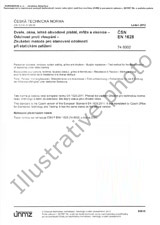We need your consent to use the individual data so that you can see information about your interests, among other things. Click "OK" to give your consent.
ČSN EN 61850-7-4-ed.2+A1 (334850)
Communication networks and systems for power utility automation - Part 7-4: Basic communication structure - Compatible logical node classes and data object classes
Translate name
STANDARD published on 1.9.2020
The information about the standard:
Designation standards: ČSN EN 61850-7-4-ed.2+A1
Classification mark: 334850
Catalog number: 510371
Publication date standards: 1.9.2020
SKU: NS-1003314
The number of pages: 622
Approximate weight : 1897 g (4.18 lbs)
Country: Czech technical standard
Category: Technical standards ČSN
The category - similar standards:
Annotation of standard text ČSN EN 61850-7-4-ed.2+A1 (334850):
A1
1.1.1 General
This part of IEC 61850 specifies the information model of devices and functions generally related to common use regarding applications in systems for power utility automation. It also contains the information model of devices and function-related applications in substations. In particular, it specifies the compatible logical node names and data object names for communication between intelligent electronic devices (IED). This includes the relationship between logical nodes and data objects.
The logical node names and data object names defined in this document are part of the class model introduced in IEC 61850-7-1 and defined in IEC 61850-7-2. The names defined in this document are used to build the hierarchical object references applied for communicating with IEDs in systems for power utility automation and, especially, with IEDs in substations and on distribution feeders.
The naming conventions of IEC 61850-7-2 are applied in this part.
To avoid private, incompatible extensions, this part specifies normative naming rules for multiple instances and private, compatible extensions of logical node (LN) classes and data object names. Any definition is based on IEC 61850 or on referenced well identified public documents.
This part does not provide tutorial material. It is recommended to read parts IEC 61850-5 and IEC 61850-7-1 first, in conjunction with IEC 61850-7-3, and IEC 61850-7-2.
This standard is applicable to describe device models and functions of substation and feeder equipment. The concepts defined in this standard are also applied to describe device models and functions for:
- - substation-to-substation information exchange,
- - substation-to-control centre information exchange,
- - power plant-to-control centre information exchange,
- - information exchange for distributed generation,
- - information exchange for distribution energy resources,
- - information exchange for metering,
- - information exchanged for hydro power plants, or
- - information exchange for wind generation plants.
- 1.1.1 Namespace name and version
This new subclause is mandatory for any IEC 61850 namespace (as defined by IEC 61850-7-1:2011).
The parameters which identify this new release of this namespace are:
- - Namespace Version: 2007
- - Namespace Revision: B
- - Namespace name: "IEC 61850-7-4:B"
- - Namespace release: 3
- - Namespace release date: 2019-10-31
- 1.3 Code Component distribution
The Code Component will be available in light and full version:
- - Full version will contain definition of the whole LNs defined in this standard with the documentation associated and access will be restricted to purchaser of this part
- - Light version will not contain the documentation but will contain the whole definition of the LNs as per full version, and this light version will be freely accessible on the IEC website for download, but the usage remains under the licensing conditions
Preview of the standard ČSN EN 61850-7-4-ed.2+A1 (334850)
We recommend:
Technical standards updating
Do you want to make sure you use only the valid technical standards?
We can offer you a solution which will provide you a monthly overview concerning the updating of standards which you use.
Would you like to know more? Look at this page.




 Cookies
Cookies
